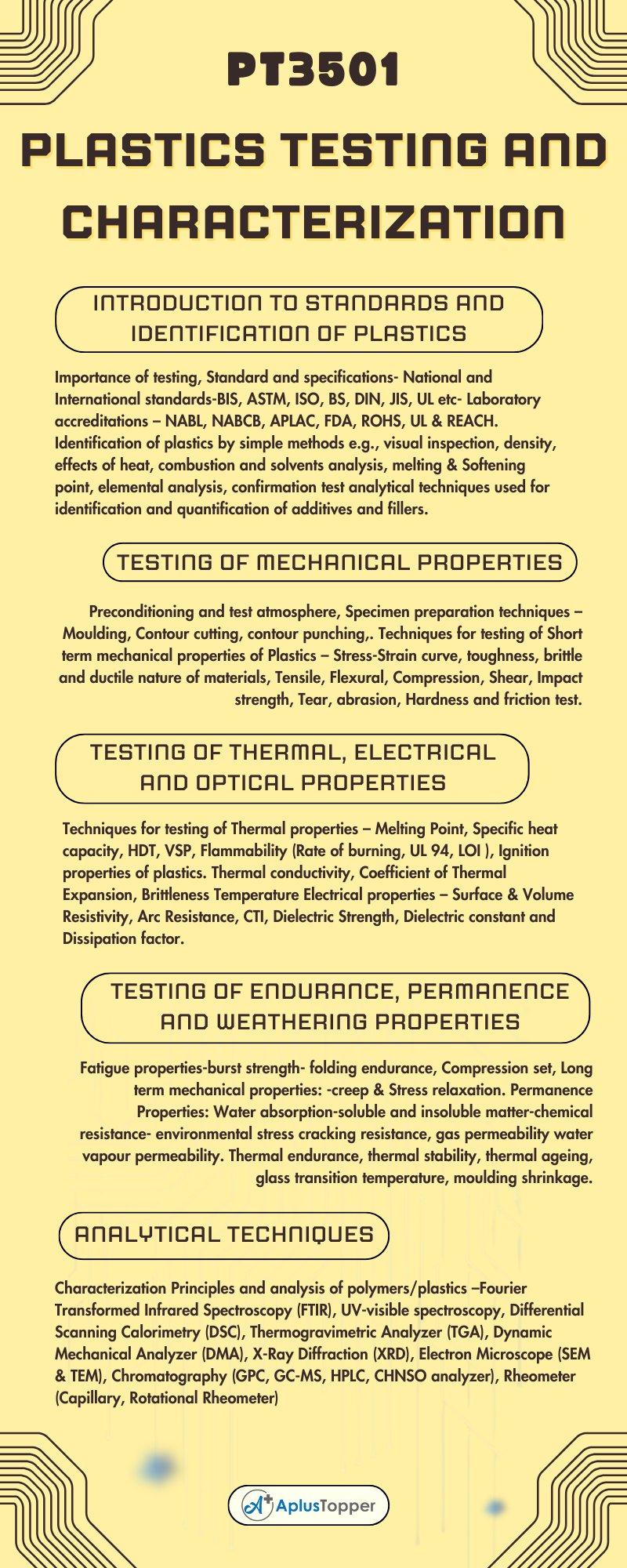In this article, we are going to discuss the B.Tech Plastics Technology, semester V, Anna University connected to the regulation 2021 subject syllabus. Let’s see what’s more…
We tried our best to provide the following unit-wise PT3501 – Plastics Testing And Characterization detailed Syllabus. We sum up the appropriate textbooks and references to this page. If you have any doubts regarding the syllabus, you can simply comment below on the following page. Hope this information is useful. Share it with your classmates. Thanks for landing on this page.
If you want to know more about the B.Tech Plastics Technology Syllabus connected to an affiliated institution’s four-year undergraduate degree program. We provide you with a detailed Year-wise, semester-wise, and Subject-wise syllabus in the following link B.Tech Plastics Technology Syllabus Regulation 2021 Anna University.
Aim of Concept:
- To develop the knowledge of National & International standards for testing methods.
- To create the knowledge about the different testing techniques and its basic concepts for evaluating the chemical, mechanical, electrical, optical, thermal, and permanence properties of plastic materials.
- To enable the students to identify and compare the properties of different plastics materials.
- To enable the students to learn about the property of the plastic material for several
PT3501 – Plastics Testing And Characterization Syllabus
Unit I: Introduction To Standards And Identification Of Plastics
Importance of testing, Standard and specifications- National and International standards-BIS, ASTM, ISO, BS, DIN, JIS, UL etc- Laboratory accreditations – NABL, NABCB, APLAC, FDA, ROHS, UL & REACH. Identification of plastics by simple methods e.g., visual inspection, density, effects of heat, combustion and solvents analysis, melting & Softening point, elemental analysis, confirmation test analytical techniques used for identification and quantification of additives and fillers.
Unit II: Testing Of Mechanical Properties
Preconditioning and test atmosphere, Specimen preparation techniques – Moulding, Contour cutting, contour punching,. Techniques for testing of Short term mechanical properties of Plastics – Stress-Strain curve, toughness, brittle and ductile nature of materials, Tensile, Flexural, Compression, Shear, Impact strength, Tear, abrasion, Hardness and friction test.
Unit III: Testing Of Thermal, Electrical And Optical Properties
Techniques for testing of Thermal properties – Melting Point, Specific heat capacity, HDT, VSP, Flammability (Rate of burning, UL 94, LOI ), Ignition properties of plastics. Thermal conductivity, Coefficient of Thermal Expansion, Brittleness Temperature Electrical properties – Surface & Volume Resistivity, Arc Resistance, CTI, Dielectric Strength, Dielectric constant and Dissipation factor. Optical properties – Luminous transmittance, Haze, Specular Gloss, Refractive Index, colour measurement, optical microscopy
Unit IV: Testing Of Endurance, Permanence And Weathering Properties
Fatigue properties-burst strength- folding endurance, Compression set, Long term mechanical properties: -creep & Stress relaxation. Permanence Properties: Water absorption-soluble and insoluble matter-chemical resistance- environmental stress cracking resistance, gas permeability water vapour permeability. Thermal endurance, thermal stability, thermal ageing, glass transition temperature, moulding shrinkage. Weathering properties: Weather and Climatic impact on properties of plastics-Natural (outdoor) and Accelerated weathering (UV-A, UV-B & UV-C), Colour fastness

Unit V: Analytical Techniques
Characterization Principles and analysis of polymers/plastics –Fourier Transformed Infrared Spectroscopy (FTIR), UV-visible spectroscopy, Differential Scanning Calorimetry (DSC), Thermogravimetric Analyzer (TGA), Dynamic Mechanical Analyzer (DMA), X-Ray Diffraction (XRD), Electron Microscope (SEM & TEM), Chromatography (GPC, GC-MS, HPLC, CHNSO analyzer), Rheometer (Capillary, Rotational Rheometer)
Text Books:
- Allen; W.S and Baker; P.N, Hand Book of Plastics Technology, Volume 2, Identification
- Testing & Recycling of Plastics, CBS Publishers and Distributors, New Delhi 2004). 3. Brown; Roger P (Ed.), Handbook of Polymer Testing, Marcel Dekker, Inc, New York (1999).
References:
- Brown; Paul F (Ed), Handbook of Plastics Test Methods, Longman Scientific and Technical, Harlow (1988).
- Shah, Vishnu, HandBook of Plastics Testing Technology, John Wiley and Sons, SPE Monograph (1984).
- Blythe; A. R., Electrical Properties of Polymers, Cambridge University Press, Cambridge (1979).
- Hubert Lobo, Jose V. Bonilla, “Handbook of Plastics Analysis”, Taylor & Francis 2003.
Must Read:
